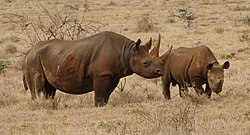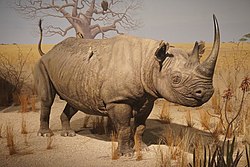Black rhinoceros
The black rhinoceros (Diceros bicornis), is a species of rhinoceros. It lives in eastern and central Africa including Kenya, Tanzania, Cameroon, South Africa, Namibia, Zimbabwe, and Angola. The black rhinoceros is not actually black, but dark. It is a browser, with lips that help eating from low branches.
| Black rhinoceros | |
|---|---|

| |
| Conservation status | |
| Scientific classification | |
| Kingdom: | |
| Class: | |
| Order: | |
| Family: | |
| Genus: | Diceros Gray, 1821
|
| Binomial name | |
| Diceros bicornis (Linnaeus, 1758)
| |

| |
| Historical black rhinoceros range (c 1700 AD) | |
Rhinoceros and oxpeckers
There is a type of bird called an oxpecker in English that likes to sit on the rhino's back and eat insects and other small animals that bite the rhino's skin. Because the birds also peck at the rhinos' skins with their beaks and hurt it, scientists wondered why the rhinos do not shake the birds off their backs. One team of scientists from California State University and Victoria University in Australia found that the black rhinoceros listens for the noises the oxpecker makes. Rhinoceros cannot see well but oxpeckers can. Oxpeckers make a noise when they see humans nearby that is different from their other noises. The rhinos hear this noise and then either look for the human or run away. The scientists performed an experiment: A human would slowly walk toward a rhino. Rhinos without oxpeckers on their backs only noticed the human one out of five times, but rhinos with oxpeckers noticed the human every time and from much further away. The scientists wondered if bringing flocks of oxpeckers to groups of rhinoceros without them would help the rhinos avoid human hunters.[1][2]
The scientists had the idea for this experiment because the Swahili language word for oxpecker is "Askari wa kifaru," which means "the rhino's guard" in English. One of the scientists said it was important to listen to indigenous peoples when studying things in the places where those people live. "We too often dismiss the importance of indigenous people and their observations," said ecologist Roan Plotz, who worked on this study. "While western science has been incredibly useful, there are many insights we can learn from indigenous communities."[1]
Threats
Black rhinoceros is currently one of the endangered species and is on the verge of extinction in Africa.There has been approximately 96% decline in its population and one of the major causes for its extinction is habitat destruction and encroachment.[3]
Black Rhinoceros Media
Black rhinoceros female, with a red-billed oxpecker and scratches on skin, in Nairobi National Park
Black rhino at Moringa waterhole, Etosha National Park
A male south-western black rhinoceros (D. b. occidentalis) in Etosha National Park, Namibia
Black rhino in the Maasai Mara
A black rhinoceros in the Savanna Bush diorama at the Milwaukee Public Museum
References
- ↑ 1.0 1.1 Cell Press (April 9, 2020). Black rhinos eavesdrop on the alarm calls of hitchhiking oxpeckers to avoid humans. Eurekalert. https://www.eurekalert.org/pub_releases/2020-04/cp-bre040220.php. Retrieved April 10, 2020.
- ↑ Roan D. Plotz; Wayne L. Linklate (May 18, 2020). "Oxpeckers Help Rhinos Evade Humans". Current Biology. 30 (10): 1965–1969.e2. doi:10.1016/j.cub.2020.03.015. PMID 32275876. S2CID 215548789. Retrieved April 10, 2020.
- ↑ Harley, E. H.; Baumgarten, I.; Cunningham, J.; O'Ryan, C. (2005). "Genetic variation and population structure in remnant populations of black rhinoceros, Diceros bicornis, in Africa". Molecular Ecology. 14 (10): 2981–2990. doi:10.1111/j.1365-294X.2005.02660.x. PMID 16101768. S2CID 43768875.









